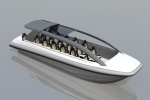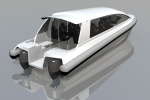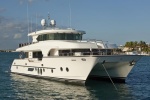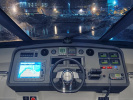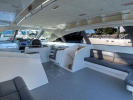Why catamaran from laminate
Why to go for a catamaran?
In comparison with monohull boats the main advantage of a catamaran is definitely comfort. This means providing full comfort to the owner and passengers thanks to the catamaran’s dimensions (especially its width), where the size of the saloon and other rooms can be easily compared to monohull boats which are larger by a third (and more expensive). Another advantage of catamarans against monohull boats are their stability and minimum keeling, two qualities which remarkably influence comfortable and peaceful sailing (no objects dropping from tables and shelves, passengers suffer less often with seasick and much more). However, the most indispensable quality of multihull boats, ships or crafts is their speed. It is not just a question of luck that the speed records of sailing boats are regularly held by specially constructed trimarans reaching a racing speed of up to 40 knots. The only disadvantage of catamarans is the usually higher mooring fees in marinas situated in “developed yachting areas“ (considering the catamaran’s width).
Why is it better to build a boat from laminate?
In comparison with other currently used materials, the one great advantage of laminate is that this material is almost “maintenance-free”. A wooden boat has to be often lifted in a dry boatyard in order to restore surface protection (dry-rot, paint). Steel boats often require the restoration of the surface by using anti-corrosion rust resistant coating paint. Except the general maintenance and antifouling paint restoration, the laminated boat does not have to be moored in dry dock storage. Another advantage of using laminate (especially alight foam sandwich construction) is that while using modern technologies (e.g. vacuum infusion) these panels, hulls as well as other parts manufactured according to the aforesaid methods, have a light weight while keeping the necessary stiffness and strength. The life expectancy of a well-built boat made of laminate is more than 20 years.
What is laminate material?
Laminate is a composite material which is usually made from two or more constituent materials with significantly different physical and chemical properties which remain separate and distinct within the finished structure. The discontinuous component is called a reinforcement (usually fibreglass, some parts of sports boats and frequently used boats are made of Kevlar or carbon) and the continuous compound (consisting of various kinds of resin) is called resin matrix. The saturation of the fibre by resin and its hardening is the origin of the hull and other parts of the boat.
Laminate or sandwich structure?
The hull (or other parts of the boat) can be made either from massive (compact) laminate (this technology is rather obsolete these days), or a layer made from light material extending the thickness of the panel is embedded between the laminate layers. The final result is represented by a lighter panel (hull) still keeping the necessary stiffness and strength. This construction is called a sandwich construction. The layer consists of light material such as balsa wood, PVC foam or honeycomb (hi-tech racing boats).
